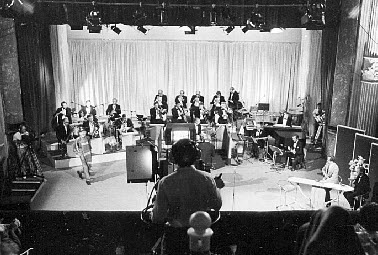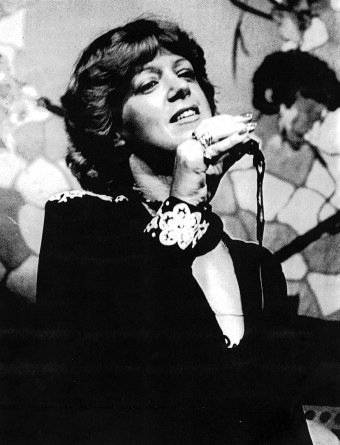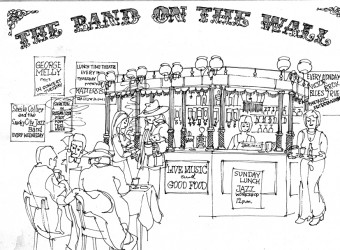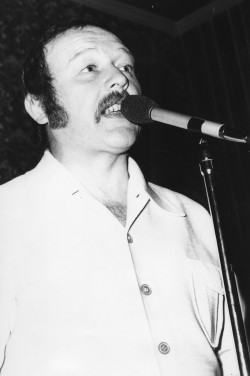Steve’s Jazzy Selection
Steve’s Jazzy Selection
Steve Morris’s approach to the music programme was old school. It came from his lengthy experience as a musician, and from his local contacts with other musicians of similar musical backgrounds. Aged 55 in 1975, Steve had been committed to music from an early age; as a 14-year-old he was reputed to have been a member of the ‘Little Rascals’ teenage jazz group in Manchester who were championed by a big-time agent and flown to New York’s fabulous Cotton Club, at that time (1934) home to the Jimmy Lunceford Orchestra. Back in Manchester, for many years Steve lived the life of the freelance musician, playing in dance bands, big bands and jazz groups, picking up work wherever he could. From time to time he also ran small businesses and managed clubs for local owners, some with gangland connections. He loved to tell the story about the day the London mafia came to Manchester to ‘take over’. Arriving at Piccadilly Station, they were met on the platform by a well-known Manchester club owner (who employed Steve from time to time to run his clubs). The clubland boss greeted the visitors by advising them to look up at the roof. There they saw several men, armed with machine guns and rifles, high up inside the roof of the station. The Mafiosi took the next train back to London, never to return.
Steve also made several trans-Atlantic crossings aboard Cunard liners, as a member of the ships’ dance bands, prior to his time at Band on the Wall. Also, for a number of years he was resident at a hotel in Bermuda where he played in the hotel band and also supplemented his musician’s wage with accounting duties, using skills he had taught himself as a young man. One of his few boasts, quietly expressed, was that the hotel owner was so pleased with his work as a musician and bookkeeper that he built a music practice outhouse in the grounds of the hotel for Steve’s sole use. Happy days, no doubt.
A Professional pool of musicians
Manchester became a mecca for musicians in the post-World War II years. There were numerous dance bands, big bands and gigging groups but “perhaps the most prestigious dance band engagement in the 1950s was that of the BBC NDO – the Northern Dance Orchestra,” according to bandleader/trumpeter Phil Moss, a good mate of Steve’s. (5). The NDO was based at The Playhouse Theatre, Hulme, later to be the short-lived Nia Centre. The NDO was reorganised as the Northern Radio Orchestra in 1975 and then was disbanded in 1985. In the NDO’s online archives Steve Morris is listed as a former member – possibly a founding member – and a featured artist with the prestigious orchestra.(6) When, in 1969, the NDO was threatened with disbandment, there was a successful national campaign to save it. The BBC’s symphonic musicians joined the campaign, threatening to gather outside Broadcasting House to perform Tchaikovsky’s 1812 Overture, using live ammunition.

Northern Dance Orchestra
Steve chose his guest soloists for Band on the Wall from the sizeable pool of experienced professionals and semi-professionals in the NDO and other Manchester-based bands, including those working in the studios of Granada Television. It was a rich pool of highly skilled players. Though the big band era was said to have long passed, there was no local shortage: “at least a dozen big bands [are] appearing regularly in the Manchester area at present,” reported the New Manchester Review in 1978.( 7) Steve already knew many of the musicians, having worked with them; others he got to know when ‘The Band’ soon became a hang-out for gigging musicians, after their evening engagements and on Friday lunchtimes for two years, 1978 & 79, when The Professionals big band took the stage.
In addition to clarinet, Steve also played alto and soprano saxes and, like Ronnie Scott, he often chose saxophonists to be featured at his club. They included featured soloists from the NDO such as Gary Cox and Roger Fleetwood; also Norman Brown who can be seen on YouTube soloing with the Andy Prior big band. (insert link) Years later, Norman’s wife, Maggie, would work the box-office at The Band. Other saxophonists booked by Steve in the late 70s included Julius Hasford, Harold Salisbury, Brian Crowther,(8) Steve Shaw and Ivor Deach who went on to form the Shades of Kenton Big Band. A particular favourite of Steve’s was multi-instrumentalist Alan Fawkes ( 9) whose full-time job was in the studios of Alfasound, the successful UK jingle production company that he founded. All of the soloists that Steve selected had substantial local reputations, mainly amongst fellow musicians, but a few were much more widely known, such as trombonist Ken Wray – ex Ronnie Scott, Jack Parnell and Tubby Hayes bands, among others – who, after years in London and on the Continent, returned to Manchester in 1968 and played at Band on the Wall on at least seven occasions in 1976, the year before his premature, accidental death. (10) Other featured trombonists at The Band were Eddie Warburton (a frequent visitor), Paul Latham, David Horley, Pete McGuire and Harry Simons. Trumpet players included Julian Cowen, Doug Whalley and Max Bullock.
If many of Steve’s chosen soloists were older, seasoned professionals, he also gave playing opportunities to younger, upcoming players, such as saxophonist Munch Manship – a pro musician since the age of 18 – and part-timers Chris Williams, alto sax, and Pete Martin, trumpet, both then university lecturers, Chris in pure mathematics; Pete in sociology. Chris later became a mainstay of Band on the Wall’s education programme, for several years running jazz courses and workshops at the club. Munch would follow him in this role, still continuing the Jazz Foundations classes in 2013. Having retired from University, Chris in 2013 was living with his American wife in San Diego, California.
Doc Martin
Some 20 years after his first trumpet gig at Band on the Wall, Dr Pete Martin became Head of Sociology (1996-8) at Manchester University and Dean of Undergraduate Studies (2000-3) in the former Faculty of Social Sciences and Law. An author specializing in the sociology of music, Pete is also a notable jazz journalist and continues to play trumpet. He has a wry sense of humour and one of his famous quips – on his becoming a Dean at the university – was: “I only ever wanted to be Dizzy Gillespie but now I’m Dean Martin.”
Steve was especially impressed by one young guitarist from Haslingden, Lancashire –perhaps an unlikely place from which to emerge a highly advanced virtuoso musician. This was Kenny Shaw. Between concerts with the ground-breaking UK jazz-rock group, Ian Carr’s Nucleus, that he joined in 1974, Kenny was booked at The Band for a Saturday night in 1976 and so impressed was Steve that he booked him for several other weekend dates during the year; more importantly, he chose Kenny’s own band with Harold Salisbury on saxes to take a weekly Tuesday night residency at the venue, from June 1976. This only ceased in April 1977 when the demands of session work took Kenny to London. Amongst those he recorded with were Elton John & Sting (11). Kenny had a lot of blues influence in his playing and often built his solos to a tremendous pitch of excitement, according to Geoff Castle, his keyboard colleague in Nucleus. The Kenny Shaw Band, a thrilling unit playing original material, with Ron Parry, then Dave Tyas, on drums and Barry Rickerby, bass, played many more times at The Band, and Kenny was also featured in other line-ups, including a guitar duo with Gary Boyle and guitar trio, Paws for Thought, with Richard Wright and Paul Mitchell Davidson. In the 60s, Gary Boyle gained an international reputation playing with high profile artists, Dusty Springfield and Lulu, and enjoyed cult success with his band, Isotope. Living in Lancashire, he continues to play.
Another member of Nucleus at that time was saxophonist Bob Bertles who also played alongside Kenny at The Band in 1976 before his return to his native Australia that year. Geoff Castle described Bertles (12) as “a fluent and inspiring player… renowned for his ability to absorb vast quantities of pizza and booze without showing any ill effect. I made the mistake of challenging him to a drinking contest in the south of France. After we had 21 glasses of Pastis, I had to chuck in the towel. Bob’s reaction was, Great, I can start drinking now.”
For the past 30 years Bertles has lived in the King’s Cross area of Sydney and is still active as a musician. He also presents a regular programme on his local jazz station, Eastside Radio. There is a YouTube clip of him performing at his local club, the long-established El Rocco, Kings Cross, Sydney, on April 7 2012.
Not all the soloists who appeared at The Band were Steve’s specific choice: some just turned up and sat in. Steve never objected, particularly when the sitters-in were of the calibre of multi-reeds player George Galway (brother of the famous flautist James Galway) and violinist Nigel Kennedy, releasing inhibitions after negotiating a concerto or two as soloist with the Halle Orchestra at the Free Trade Hall.
The Resident Band
Before Steve had even launched the club or considered which soloists would be featured, he needed to book an accompanying group. Steve travelled to Bury to see a band and during an interval at the gig at The Bridge Inn he asked the drummer Allan Tattersall about forming a resident group. Steve said, “We are thinking of opening the Band on the Wall again…. We are going to redo it, renovate it and open again, just for jazz.” (13)
Allan formed a trio with Dave Roberts on piano and Pete Briggs, electric bass, often with the addition of vocalist Al Baron. This was the resident group that performed regularly on Fridays and Saturdays, and occasionally on other nights of the week from 1975 to mid 1979. The billing in the local evening newspaper was:
A Great Trio. A Great Singer and a Beautiful Atmosphere (14)
(MEN advertisement, October 15, 1975).

Drummer Allan Tattersall at Band on the Wall, late 1970s
Allan Tattersall went on to become not only an established drummer but also a world-renowned martial arts exponent, with 26 Dan Grades in the arts of jujitsu, iaido, aikido, aikjitsu, bujutsu and karate.
On weekend nights, Steve Morris could often be heard in the cellar of the club, warming up on clarinet or alto sax, after he had prepared staff wages, band fees and paperwork for the night. He would then emerge from the bowels of the building and, guarding his instrument, find his way through the audience and join the group on stage. With the resident group, he would play favourites such as ‘Girl from Ipanema,’ ‘There is no Greater Love,’ as well as a catchy, own composition by Steve, modestly titled ‘C7,’ the chord on which it was based. Often, on leaving the stage, Steve would be the recipient of kisses from women, young and old, as he crossed the dance-floor – the only exit route from stage prior to the improvement works of 2009. Mildly embarrassed but smiling broadly, he would return his precious clarinet or saxophone to the cellar, ready for serious practice the following day, in between the many duties of managing the venue.
Double Diamond Dave
Resident pianist Dave Roberts was known to enjoy a drink: “Double Diamond Dave, we called him,” said one of the musicians who worked with him. Another musician who played with him put it this way: “Sober, Dave was a lovely piano player but after he had a drink his notes became fewer and fewer. In fact I realised that the amount of notes that he played was in inverse proportion to the amount of drink he had — to the point that when he had a skinful he would get up and dance round the piano: no notes at all.” Others who occasionally took the piano seat were Pete Hernon, Andy Hickey, John Rotherham and Lithuanian-born virtuoso Balis Novak.
Steve Forster, who was Assistant Manager from 1982 to 1988, tells a true story about Dave Roberts and Balis Novak. The following is an excerpt from his ‘Memories of The Band’.
Anecdotes from this time include the time that the regular weekend piano player, Dave Roberts, famous for enjoying a drink or 20, was a bit beyond hitting the right notes (or at least hitting them in the right order). In the audience was his sometime stand in, tall Russian pianist Balis Novak who, seeing the problem, calmly walked onto the stage and, standing behind Dave, added his right hand to play the melody. Unaware of this Dave looked down, saw three hands playing, shook his head, got up and left the stage figuring that if he was so drunk that he appeared to have 3 hands he should stop playing there and then.
Watch this 1982 video by bluesman Norman Beaker with Balis Novak.

Steve Forster at the sound desk, Band on the Wall, early 1980s
From the end of June 1979, Steve Morris booked a new resident trio, led by a young pianist Steve Jaffa, a prolific composer of attractive melodies. On double bass was Ian Croal and there were a few different drummers, including Geoff Brain, Dave Tyas and, returning occasionally, Allan Tattersall. With the regular addition of Julius Hasford on tenor sax, the group began to intersperse the normal repertoire of jazz standards with Jaffa’s tunes.
In 1975/76, the admission charge for the regular performances at weekends was 25p before 9pm and 50p after 9pm. The venue was open to 2 am at the weekends, and midnight or 1 am during the week. In this period, The Band was advertised in the Manchester Evening News as open for ‘Live Music Every night,’ though the Sunday night opening ceased after August 1976, until the Manchester Musicians Collective took that regular night from October 1977.
Traditional Jazz
The longest-running weekly residency at The Band was by Sheila Collier and the Smoky City Jazz Band on Wednesday nights – for over six years. From time to time this highly-rated traditional band was augmented by visiting stars, such as trombonist George Chisholm (September 24 1975). Sometimes The Smoky City supported entire visiting bands such as The Harbour Jazz Band, billed in the Manchester Evening News advert as ‘Dixie goes Dutch, including ex members of the Dutch Swing College.’ The concert on Friday October 10 1975 was recorded by Piccadilly Radio for Piccadilly Jazz Club and may have been the first radio broadcast from Band on the Wall.

Sheila Collier photographed at Band on the Wall, late 1970s
John Hallam, saxophonist with the Smoky City for several years, recalls: “It was one of the best residencies we had during my time with the band. It always had a good buzz and we had lots of musicians dropping in to see us and many of them sitting in.” The band’s last gig at The Band was on 8th July 1981. From 1982, The Smoky City Jazz Band, led by trumpeter Bill Smith – but without Sheila Collier – was active until 2007.
In 2013, vocalist Sheila Collier was living in Sweden and still performing, including dates in Holland with the Big Chris Barber Band. Sheila’s ‘Memories of The Band’ can be forund here.

Sketch of Band on the Wall, from ‘Manchester Music’ by Albin Trowski. Posters on the left display ‘Sheila Collier and the Smoky City Jazz Band’ also ‘George Melly’
Steve was not a trad jazz musician; his style was more Swing-based. On clarinet he particularly admired Artie Shaw, also Ed Hall; on alto sax, he was in awe of Charlie Parker who he claimed to have seen in a 52nd Street club on one of his Cunard trips to New York in the early 50s. But he enjoyed traditional jazz bands and this is reflected in his bookings in the 70s. The local Dave Donohoe’s New Orleans Jazz Band was booked more than a dozen times in 1976/77, and other occasional bookings were: the Panama Jazz Band – “the West Country’s best choice for weddings, social events and corporate entertainment”;(15) Max Collie’s Rhythm Aces and George Melly with John Chilton’s Feetwarmers.








